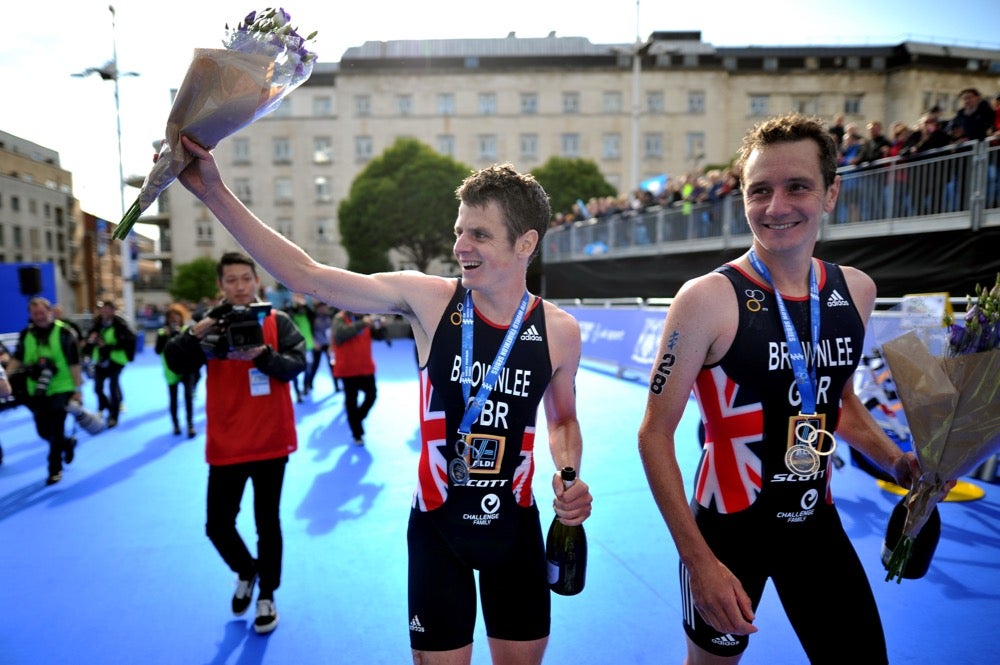The Brownlee Effect: Why Triathletes Are Bigger Celebs in the UK than the US

The Brownlee brothers acknowledge the crowd in Leeds. Photo: Janos Schmidt/Triathlon.org
Will triathletes ever be celebrities in the mainstream?
Turn on a television in Europe, and you might just do a double-take during the commercial break: Is that…Alistair and Jonny Brownlee? Are they…doing arm curls with…grocery sacks? Yes, it is, and yes, they are. The celebrity spokespersons for one of the largest supermarket chains in the world are none other than The Brothers Brownlee.
Alistair and Jonny are no strangers to commercials. In addition to their television spots for Aldi, the brothers have a cheeky commercial for Yorkshire Tea that pokes fun at their sibling rivalry. In 2011, they appeared alongside the (now-infamous) paralympian Oscar Pistorius in a commercial for BT Infinity, a fiber-optic broadband company.
Though major brand sponsorship is nothing new in triathlon, the utilization of triathletes as spokespersons has been generally limited for advertising to other endurance athletes.
“There have been a few larger, non-endemic brands that have utilized triathletes,” says Michael Cardoza, Director of sports management firm Human Interest Group. “For instance, Crowie’s chocolate milk campaign was on every five minutes during the Tour de France one year, but they seemed to be targeting this market specifically. There’s nothing really like what the Brownlees do.”
But why? And how? One could argue the Brownlees’ success in the sport gives them celebrity status. But if that’s the case, why don’t we see similarly dominating triathletes like Gwen Jorgensen, Flora Duffy or Jan Frodeno sipping Folgers or sprinting through the aisles of a Target commercial during must-see TV?
“Certainly, the Brownlees are at a level of performance that the sport has never seen before,” says Franko Vatterott, founder of Human Interest Group. “They are exceptional by any sport’s bar.” But their mass appeal lies in two key elements: a good story and a better market.
The Jorgensens and Frodenos of the sport, Vatterott argues, don’t have quite the same human interest levels as a pair of brothers racing against each other. Seeing Alistair and Jonny race side by side touches something in almost every viewer—who hasn’t raced their sibling to be the first one to get to the tray of cookies or call dibs on riding in the front seat of the car? Watching the Brownlees race is intriguing if only for the fact that we secretly hope one shoves the other out of the way, just like we did our own siblings. It’s the reason the Yorkshire Tea commercial—where the Brownlees do just that—works so perfectly.
Murphy Reinschreiber of sports marketing agency PCH Sports says the market is just as important as the story: “Cycling sports are high profile in the U.K. Alistair successfully defended his gold with his brother taking silver—a unique story, yes, but Great Britain won 27 gold medals as opposed to the USA’s 46, making Great Britain’s medalists more newsworthy.”
There’s also a big difference in the way sports are covered in the two countries. Triathlon, as a single day and single race event, is easily lost in the way U.S. television markets focus on multi-day/multi-medal sports such as swimming, track & field, and gymnastics, where, as Reinschreiber says, “heroes are built to drive viewership night after night.”
Cardoza agrees, citing 28-time Olympic medalist Michael Phelps as an example. “If he had only won three medals over his Olympic career, which is still an amazing feat, then he would be used in marketing far less than he is now. Swimming is really only watched every four years, and it took an unthinkable accomplishment to get Americans to even know who he was.”
In Britian, ITU racing has a strong following, even in non-Olympic years. Televised races get good ratings, and large crowds of spectators often assemble at events. At the 2017 Columbia Threadneedle ITU Leads, where the Brownlees headlined the men’s professional field, the entirety of the race course was lined with spectators, often three or four (or more) deep. Triathlon, simply, is a bigger deal in Britain. In the United States, where football, basketball, baseball and golf drive sports media, triathletes simply don’t carry enough weight to get the attention of major brands. Almost every American knows who Kevin Durant and Tom Brady are; Gwen Jorgensen, not so much.
That’s not to say it’s impossible for a triathlete to get a mainstream endorsement deal in the United States. With the right story and the right brand, it can happen. Agents like Vatterott, Cardoza and Reinschreiber work hard on the daily to make it so. As age-group participation and coverage of the sport grows (especially with mixed relays coming to the 2020 Olympics), they hope triathletes will gain more recognition.
“A good comparison is some of the stars on the U.S. Women’s Soccer Team. Soccer is not a big sport professionally in the U.S., but the country has now gotten behind them, turning several of them to celebrities—Alex Morgan, Abby Wambach, even going back to Mia Hamm. I think if triathlon could even get to the level of women’s soccer in the U.S., we would see many more marketing opportunities for triathletes, like the Brownlees in the U.K.”